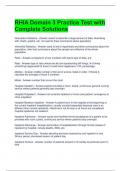RHIA Domain 3 Practice Test with
Complete Solutions
Descriptive Statistics - Answer-meant to describe a large amount of data, illustrating
with charts, graphs, etc. not used to draw conclusions about population
Inferential Statistics - Answer-used to test a hypothesis and draw conclusions about the
population, infer that conclusions about the sample are reflective of the whole
population
Ratio - Answer-comparison of two numbers with same type of data, a:b
Rate - Answer-type of ratio where two #s are representing diff things, # of times
something happened/# of times it could have happened x 100, percentage
Median - Answer-middle number of the set of scores, listed in order, if theres 2,
calculate the average of those 2 numbers
Mode - Answer-number that occurs the most
Hospital Inpatient - Answer-patient provided w room, board, continuous general nursing
service where patients generally last overnight
Hospital Outpatient - Answer-not currently inpatient or home care patient, emergency or
clinic outpatient
Hospital Newborn Inpatient - Answer-A patient born in the hospital at the beginning of
the current inpatient hospitalization, usually counted separately because care is so
different than normal inpatients, infants born not he way or at home are considered
hospital inpatients not newborn
Inpatient Admission - Answer-acute-care facilities formal acceptance of a patient to be
provided with room, board, continuous service where patients stay overnight
Inpatient Discharge - Answer-termination of hospitalization through formal release of
inpatient by hospital, include deaths, AMA, etc.
Inpatient Service Day - Answer-denoting services received by one inpatient in one
24hour period, shortened version of patient day
Inpatient Census - Answer-number of patients present in hc facility at particular point in
time
,volume measure, automated process, can pull census data at any given time, census
data can be different throughout the day, Midnight is common census taking time
Daily Inpatient Census - Answer-census data reported at midnight/other official time, all
patients present at midnight, plus any patients admitted/discharged that same day,
A&D, need this to accurately represent throughout the whole day, separate for A&C and
then newborn reporting, also includes numbers transferred in and out,
remaining, admitted, transferred in, transferred out, discharged, died, subtract those 3
after adding, and get total daily census
Inpatient Service Days - Answer-reflects services received by one inpatient during 24 hr
period, IPSD, daily inpatient census= inpatient service day for that day, important
measure of volume of services provided by facility, reported on daily, basis
Average Daily Census - Answer-average number of inpatients treated during given
period of time, # of inpatient service days for that period/ # of days in that period,
separate for newborns
Census Reports - Answer-monthly, quarterly, annually, created to give bigger picture of
census activity
Inpatient Bed Occupancy Rate - Answer-total number inpatient service days/total
possible inpatient service days for that period/total bed count possible for that period x
100, is possible to report a rate over 100%,
Hospital Bed Turnover/Bed Turnover Rate - Answer-how man times each bed was
occupied in a given period, number of discharges for time period/bed count for same
time period
represents on average, each bed had __ patients occupying it for month of ___, not
multiplied by 100
LOS - Answer-number of days patient occupied a bed, day of discharge not counted,
day of admission from day of discharge, break it up by month, total length of stay for all
patients added up for total LOS, number of days care was provided to patients
ALOS - Answer-average LOS, total LOS for period/total number of discharges for same
period
Hospital Death Rate - Answer-number of patients discharged total during specific time
period
Gross Death Rate - Answer-total number of deaths in period/total number of discharges
in same period x 100, includes newborns
Net Death Rate - Answer-adjusted so that certain deaths are not counted, more
accurate measure, no deaths within 48 hours of admission,
, total # inpatient deaths - (<48 hr deaths) / total number of discharges - (<48 hr deaths)
includes newborns in each
Newborn Death Rate - Answer-# of newborns who died in comparison to total # of
newborns discharged alive and dead
total # NB deaths for period/ total # of NB discharges including deaths for period
Fetal Death Rate - Answer-death of stillborn, before mother gives birth,
total # intermediate/late fetal deaths for period/ total # live births plus ^ for period
Maternal Death Rate - Answer-death of any woman from related to pregnancy,
total # direct maternal deaths for period/total # of maternal discharges for same period
Gross Autopsy Rate - Answer-includes all deaths that occur with inpatients, proportion
which an autopsy was performed,
total # autopsies on inpatient deaths/ total # inpatient deaths
5/18 x 100= 27.7%
Net Autopsy Rate - Answer-bodies of patients not available are removed from
denominator,
total # autopsies/ total # inpatient deaths minus ones can't autopsy x 100
Hospital Autopsy Rate - Answer-anyone who died in hospital
Hospital-Acquired Infection Rate - Answer-nosocomial infection rates, indicate rates of
infections that were acquired during the hospital stay, calculated for entire hospital,
total # HAI for given period/ total # discharges for same period x 100
Post-Op Infection Rates - Answer-infection that occurs after clean surgical case, no
infection during surgery,
# infections in clean surgical cases/ total # operations for same period x 100
CMI - Answer-case mix index, weighted average of sum of RW of all patients treated,
add all DRG RW together, and all Volume/#of discharges, divide total RWs by total
discharges
NVSS - Answer-National Vital Statistics System, used to collect vital stat info, data
sharing org each state disseminates vital stat registry data, standardized forms, access
real time data
Epidemiology Stats - Answer-based on large populations through public health
agencies, study of distribution/determinants of health problems, scientific method,
Information Management - Answer-The generation, collection, organization, validation,
analysis, storage, and integration of data as well as the dissemination, communication,
presentation, utilization, transmission, and safeguarding of the information




